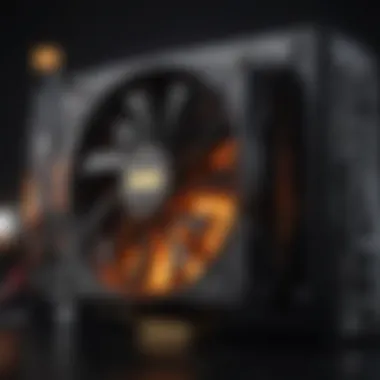Top Video Cards: Comprehensive Performance Assessment


Intro
In the fast-paced world of technology and gaming, video cards play a crucial role. The performance and capabilities of these graphics processing units (GPUs) can make a significant difference in the gaming experience, graphical quality, and even the proficiency of computation for various professional tasks. With new innovations and releases flooding the market, discerning which video card best suits one’s needs can feel like navigating a maze.
This exploration aims to dissect the top video cards available today. We will wade through the murky waters of specifications, performance metrics, and user feedback to shine a light on what truly matters when it comes to gaming and graphic-intensive applications. Along the way, we’ll touch on the latest technological advancements that are shaping these components, as well as the notable trends emerging within the industry.
By the end of this piece, readers should leave with a comprehensive understanding of the video card landscape, enabling informed purchasing decisions that align with their particular gaming or computational requirements.
Understanding Video Cards
In the rapidly evolving landscape of computer technology, video cards play a monumental role in defining user experience, particularly for gaming and graphic-intensive applications. Understanding the intricacies of video cards is essential for anyone looking to dive into high-performance gaming or professional graphics work. Considering the significant impact these components have on performance, it’s crucial to dissect their functionalities and capabilities.
Why Video Cards Matter
Video cards, or graphics processing units (GPUs), serve as the powerhouse behind rendering images, video, and animations. Without a competent video card, graphical output can become a pixelated nightmare—completely draining the immersive experience of high-definition gaming. By grasping how video cards function, users can make informed decisions about upgrades and purchases that most align with their computing needs.
The Benefits of Understanding Video Cards
- Improved Performance: Knowledge about video cards can help identify which models will provide the best performance for specific tasks whether it’s for gaming, video editing, or deep learning tasks.
- Cost-Effective Choices: Understanding the features and specifications allows users to find options that deliver the best value for their budget—avoiding spending on unnecessary high-end models when less expensive alternatives will suffice.
- Future-Proofing: The technology behind video cards is ever-changing. A comprehensive understanding can aid in selecting a card that not only meets current needs but is equipped to handle future advancements.
"A great video card can be the difference between a gaming experience that feels fluid and one that feels painful and glitchy."
By exploring broader concepts like the role of video cards, their key components, and the technology behind them, readers can forge a strong foundation for making educated choices. The following sections will dissect these elements more thoroughly, shedding light on what makes a great video card and the factors that influence purchasing decisions.
Criteria for Selection
When diving into the realm of video cards, understanding the criteria for selection is paramount. This aspect not only defines the factors influencing a consumer’s decision but also aligns those with their specific needs—be it gaming, graphic design, or general use. Each criterion serves as a compass, guiding users through the murky waters of options available in the market.
Performance Benchmarks
Performance benchmarks represent the backbone of any effective analysis of video cards. They offer tangible metrics that allow for comparison across different units. When assessing a video card, one should consider metrics like frame rates, rendering times, and overall stability during demanding applications.
Benchmarks often come from rigorous tests, pushing the hardware to its limits across various scenarios. For instance, running games at high settings can showcase how a card handles visuals versus computational tasks. Popular tools like 3DMark and Unigine Heaven serve as the go-to benchmarks for serious gamers wanting raw data about performance.
Not only do benchmarks inform users about how cards perform in ideal conditions, but they also expose any shortcomings under intensive loads. One must take note of how cards hold up in real-world, extended use, as this often reflects the experiences of many users.
Power Consumption and Efficiency
In an era where power efficiency is a growing concern, noting a video card's power consumption is becoming just as crucial as its performance. A powerful card that guzzles energy may lead to higher electricity bills and could necessitate more robust cooling solutions, which in turn can affect overall system costs.
An efficient video card not only lowers utility expenses but also results in cooler operation and longer lifespan for system components. Power draw is usually measured in watts, where lower wattage often indicates superior efficiency. This aspect is important, especially for those building or upgrading systems without an infinite budget.
Feel free to assess whether cards feature low power states or advanced power management technologies. These elements can significantly reduce consumption when high performance isn't necessary, ensuring that users aren't just throwing money out the window.
Price to Performance Ratio
No discussion on criteria would be complete without addressing the price to performance ratio. This concept encapsulates the value derived from a video card against its cost. It’s not merely about getting the highest performance; it’s about making sure that the performance justifies the price tag attached.
Several price points exist to accommodate every type of user, from casual gamers to hardcore enthusiasts who demand top notch hardware. It’s useful to create a balance between how much you're willing to spend and what kind of performance you’re expecting. If a video card provides excellent specs but costs a fortune, it might be wise to consider alternatives that could deliver similar performance without breaking the bank.
For instance, a mid-range card might perform adequately for most gaming needs without incurring the costs associated with high-tier cards like the NVIDIA GeForce RTX 3090. A deeper dive into user reviews and expert comments can lend credibility to perceived values, helping potential buyers strike the right balance.
"A genuine value in video cards isn't just how fast they can render a frame, but how they stand the test of your wallet and expectations."
Top Video Cards Overview


Understanding the landscape of video cards is crucial for anyone interested in gaming, content creation, or graphic design. The variety of options available today can make choosing one feel like finding a needle in a haystack. This section aims to distill the details surrounding the top video cards currently on the market, spotlighting relevant features and real-world applications.
NVIDIA GeForce RTX Series
The NVIDIA GeForce RTX series remains at the forefront of graphics technology. Recognized for their strong performance and cutting-edge features, these cards cater to a wide spectrum of users.
Key Features
NVIDIA's GeForce RTX series is lauded for its ray tracing capabilities. This technology enhances realism in games by simulating the way light interacts with objects in a virtual environment. Furthermore, DLSS (Deep Learning Super Sampling) boosts frame rates while maintaining image quality. Such features aren’t just gimmicks; they significantly elevate the gaming experience. Therefore, this series is often viewed as a market leader due to its advanced technology.
Target Audience
The RTX series attracts various audiences, from hardcore gamers seeking top-tier performance to professionals needing reliable hardware for design applications. Moreover, the versatility of these cards makes them appealing for VR users, providing an immersive experience without lag. On the flip side, the high price point may deter budget-conscious consumers.
Performance Analysis
A thorough examination of the RTX series reveals substantial benchmarks. Generally speaking, these cards outperform their predecessors and many competitors. With extensive support for high-refresh-rate monitors, users can enjoy seamless gameplay. Still, it’s important to note that not everyone requires such power, which can make these cards seem overkill for casual gaming.
AMD Radeon RX Series
AMD’s Radeon RX series has established itself as a serious contender in the graphics market. Known for their competitive pricing and solid performance, these cards showcase several unique advantages.
Unique Selling Points
One standout aspect of the Radeon RX series is its AMD Smart Access Memory technology. This enables the CPU to access the GPU’s full memory, which can improve performance in certain applications. Users often find GB-per-dollar ratios more favorable here, allowing budget strap-on gamers to maximize raw power.
Game Compatibility
When it comes to compatibility, many titles run smoothly on Radeon cards. This adaptability extends to popular games, which are increasingly designed to leverage the strengths of AMD hardware. However, some users report driver issues, which may occasionally mar their experience with specific games.
User Feedback
The sentiment surrounding the RX series tends to be largely positive. Online forums indicate that users appreciate the value offered, though some flag concerns over customer support. Recognizing the balance between cost and reliability means enthusiasts generally find these cards to suit their needs for performance without breaking the bank.
Budget-Friendly Options
For those who are careful with their finances, budget-friendly video cards are more viable than ever, offering a gateway into gaming without spending a fortune. Moreover, these models often strike a balance between performance and cost-effectiveness.
Recommended Models
In the realm of affordability, cards from models like the RX 570 and GTX 1650 have garnered attention. These options perform well at 1080p settings, making them suitable for casual gamers. Meanwhile, it's worth noting the increasing performance of integrated graphics solutions, which can be enough for less demanding applications.
Cost-Benefit Analysis
A cost-benefit analysis of these cards usually reveals that while performance might lag behind higher-end models, a significant percentage of gamers don’t require extreme capabilities. Consumers can enjoy decent frame rates and visuals without emptying their wallets.
Ideal Use Cases
Budget-friendly models shine in various use cases, particularly for casual gaming, multimedia consumption, and basic creative tasks. It’s clear that while they may not compete with elite cards, they cater effectively to a wide range of user needs, providing sufficient performance for most common applications.
"Choosing a video card doesn't have to be complicated. Understanding your needs can lead you to the right choice."
As we examine the varied selections among top video cards, it's evident that understanding your specific requirements is paramount. Whether prioritizing cutting-edge technology, value for money, or general compatibility, this overview equips readers with a nuanced view to navigate the ever-evolving landscape of graphics hardware.
Advanced Features of Modern Video Cards


Modern video cards have evolved far beyond just powering simple graphics. They now incorporate cutting-edge technologies that not only enhance visual fidelity but also introduce new gameplay experiences and efficiencies. Understanding these advanced features is essential for anyone looking to maximize their gaming or computational setup. The significance lies not just in the performance, but also in how these elements reshape user experience across various applications.
Ray Tracing Technology
Ray tracing stands at the forefront of graphics technology. It simulates the way light interacts with objects in the virtual environment, producing more realistic shadows, reflections, and lighting effects. Whereas traditional rendering methods might resort to approximations, ray tracing delivers visuals that can be likened to watching a movie in terms of realism.
This technology is not merely for eye candy; it plays a pivotal role in immersive gaming. Games like Cyberpunk 2077 and Control showcase how ray tracing can transform gameplay, making environments feel alive and engaging. When considering a video card, one should evaluate its ray tracing capabilities. Graphics cards such as the NVIDIA GeForce RTX series have built-in cores specifically designed for this purpose, making them stand out.
However, users should also be mindful of the performance cost. While ray tracing enhances visual quality, it may come at the expense of frame rates. Thus, balancing this feature against one's hardware and needs is crucial. In summary, ray tracing technology represents a significant leap in how games are rendered, offering unparalleled realism that enriches user experiences.
AI and Machine Learning Enhancements
The infusion of artificial intelligence into video cards has opened up innovative avenues that were unimaginable a few years ago. AI can optimize performance by dynamically adjusting settings based on real-time data, ensuring a smoother gaming experience without manual intervention. Moreover, features like NVIDIA's DLSS (Deep Learning Super Sampling) use machine learning algorithms to upscale lower resolution images into higher resolutions, preserving visual quality while boosting frame rates.
The implications for gamers are profound. Imagine enjoying high-resolution textures without the typical performance hit associated with rendering at full resolution. This not only enhances gaming experience but also broadens accessibility for players with varying hardware capabilities.
Nevertheless, it's important to approach these AI enhancements with a critical eye. While they promise improvements, their effectiveness can vary based on the specific game and, in some cases, may lead to artifacts that detract from the experience. Therefore, users should research and ensure that the games they play benefit from these enhancements.
Support for Virtual Reality
As virtual reality gains traction, having a video card that effectively supports VR becomes increasingly important. High-performance video cards are necessary to render vibrant, immersive VR environments with minimal latency. Latency issues can lead to disorienting experiences, which detract from the immersive sensation VR aims to provide.
Key features to look for in a VR-capable card include high refresh rates and robust resolution support. Cards like the AMD Radeon RX series are engineered to handle the demanding specifications of VR headsets, ensuring smooth performance that transports users into alternate worlds.
Additionally, some graphics cards come equipped with features that enhance VR experience, such as better field-of-view capabilities and improved frame pacing. As developers continue to explore VR's potential, these enhancements will likely become a core component of future video card iterations.
Comparative Analysis
The comparative analysis section serves as the backbone of understanding the dynamic relationship between major players in the video card market, specifically NVIDIA and AMD. By breaking down their varied approaches and distinct features, users gain valuable insights that aid in making informed choices based on individual preferences and performance needs. This analysis not only highlights the technical specs but also considers market trends, pricing strategies, and the impact of generational improvements on the gaming experience.
NVIDIA vs AMD
Performance Metrics
When diving into performance metrics, we delve into how these video cards handle demanding tasks. NVIDIA’s GPUs often excel at tasks with superior ray tracing capabilities, thanks to their architectural design, such as the Ampere series. Users often notice that frames are more stable during high-load periods, a key characteristic that builds NVIDIA’s reputation.
In contrast, AMD’s Radeon cards, particularly those based on the RDNA architecture, have made significant strides. They offer comparable performance, especially in rasterization, while typically providing better value per frame than their NVIDIA counterparts.
"Choosing a GPU is like picking a knight for battle; you need to understand their strengths and weaknesses in various scenarios."
This aspect of performance metrics is indispensable as it can dictate a user's gaming experience. For instance, if an individual is into competitive gaming, they might prefer the lower input lag and higher refresh rates associated with NVIDIA cards.
Pricing Strategy
NVIDIA typically positions itself in the premium segment. They offer cutting-edge technology which, while reflected in a higher price tag, attracts users willing to pay for the latest features. Moreover, they have a history of maintaining their product line's value over time. This pricing strategy is appealing for long-term investments but can deter budget-conscious consumers.
On the other hand, AMD has carved a niche by providing robust performance at comparatively lower prices. Their strategy is appealing for gamers looking to maximize performance without breaking the bank. However, the trade-off often comes into play regarding some advanced features, such as ray tracing, which might not perform as well as NVIDIA’s offerings. Understanding the nuances here can help buyers decide which card aligns better with their financial constraints and performance needs.
Market Share
Market share is another telling element in this comparative analysis. NVIDIA has enjoyed a significant lead in the high-end GPUs segment, owning nearly 80% of the market. This dominance often stems from their investment in research and development, resulting in innovative products that push the boundaries of what graphics cards can do. This is beneficial for maintaining brand loyalty and attracting developers to optimize games for their GPUs.
In contrast, AMD has been gaining market share especially in recent years due to their aggressive pricing and competent performance. They target budget-conscious gamers and those interested in solid performance without the premium price, making AMD a popular choice in the mid-range segment. This ongoing shift has compelled NVIDIA to become more competitive with its pricing strategies, thus benefiting the broader consumer base.


Generational Improvements
From Previous Generations
Evaluating the generational improvements reveals how far video card technology has come. NVIDIA’s transition to the Ampere architecture from Turing has yielded significant boosts in performance efficiency and power consumption. Not only do these cards outperform their predecessors, but they also support the latest features such as DLSS and improved ray tracing capabilities. This advancement illustrates technology’s rapid progression, emphasizing the importance of staying current with hardware.
AMD’s leap to RDNA from GCN has similarly transformed their offerings. Users saw marked increases in performance per watt, addressing concerns about power efficiency. This evolution showcases AMD's commitment to innovating while providing competitive products. Both these improvements serve users looking for the best return on their investment, laying out clear paths from old generations to the new.
Impact on Gaming Experience
The impact of these generational improvements on gaming experience cannot be understated. As games become more demanding, gamers are increasingly investing in hardware that can provide headroom for future titles. The enhancements introduced by both NVIDIA and AMD lead to smoother gameplay, higher frame rates, and overall better graphics fidelity. This results in a more immersive experience where players can appreciate the visual storytelling in gaming.
The key takeaway here is that the effectiveness of generational shifts greatly influences how players interact with their favorite titles. Whether it’s lower loading times, higher resolution gameplay, or the ability to utilize VR features, both NVIDIA and AMD are responding to the needs of their audience, ensuring that gaming is not just a leisure activity but a captivating experience.
Future Trends in Video Card Technology
The realm of video cards is constantly evolving, and with it comes a host of future trends that promise to redefine not only gaming but also various computational tasks. Understanding these trends is critical for tech-savvy individuals, gaming enthusiasts, and anyone invested in graphic-intensive applications. This section examines two significant areas: emerging technologies, which include quantum computing and next-gen GPUs, and sustainability in manufacturing practices.
Emerging Technologies
Quantum Computing
Quantum computing stands out as a frontier that could revolutionize not just video gaming, but computational processes at large. Unlike classical computing, which relies on bits as either 0s or 1s, quantum computing uses qubits that can represent and store information in multiple states simultaneously. This characteristic allows for unprecedented parallel processing capabilities.
One of the key advantages of quantum computing is its potential to solve complex problems that conventional computers struggle with, such as optimization and simulation tasks. When combined with graphics processing, this could lead to highly detailed and realistic environments in video games, resulting in an immersive experience that players have only dreamed of. However, deploying quantum algorithms seamlessly with existing video card architectures presents significant challenges, primarily due to the nascent state of the technology and the need for specialized hardware.
Next-Gen GPUs
Next-gen GPUs are anticipated to bring a great leap in performance compared to their predecessors. With advancements primarily focused on processing power and power efficiency, these graphics cards aim to offer smoother frame rates, enhanced graphics quality, and more robust support for new rendering techniques. The promise of features like improved ray tracing and even better AI capabilities is enticing, making them a popular choice for those looking to future-proof their gaming setup.
What sets next-gen GPUs apart is their ability to incorporate machine learning, allowing for dynamic adjustments in performance and power consumption based on gaming needs. This adaptability can result in a much more efficient overall performance in long gaming sessions. However, the downside is that these cutting-edge cards can demand a high initial investment, potentially limiting access for budget-conscious gamers.
Sustainability in Manufacturing
As the demand for video cards continues to rise, so does the call for a more sustainable approach to their manufacturing. Environmentally friendly practices are becoming more critical, not just for reducing waste but also for optimizing resource use. Companies are beginning to adopt greener methods of producing video cards, such as utilizing recyclable materials in their designs and employing energy-efficient manufacturing techniques.
The shift towards sustainability could also result in a better public image and, ultimately, more consumer loyalty. Gamers today are increasingly aware of the environmental impact their purchases have, and companies that take steps to address these concerns may find themselves at a considerable advantage in a competitive market.
The landscape of video card technology is shifting, making it essential for enthusiasts and professionals alike to stay informed about these developments to make knowledgeable purchasing decisions.
Epilogue
In wrapping up the discussion on video cards, it's essential to acknowledge their pivotal role in modern computing. As the backbone of visual rendering, video cards not only enhance gaming experiences but also power a variety of applications that demand high graphical fidelity. Given how quickly technology evolves, understanding the characteristics of top video cards is beneficial for consumers and enthusiasts alike.
This article has distilled complex information into more digestible parts, which empowers readers to navigate through the myriad of options available on the market. We examined various features including GPU capabilities, VRAM specifications, cooling solutions, and even the underrated aspects like power efficiency. These factors, when taken together, can fundamentally alter gaming and overall computing experiences.
Moreover, the insights drawn from performance benchmarks and user reviews shed light on the real-world efficacy of these products, making the decision-making process less daunting. The considerations of price versus performance also offer an avenue for budget-conscious gamers; it's not just about spending the most money but about deriving the most value.
"Investing in the right video card is akin to choosing the right tool for a job; it defines your productivity and satisfaction."
The section of emerging technologies hints at what lies ahead in video card innovation. Keeping abreast of these trends ensures that users not just meet current gaming requirements but also prepare for future advancements. As we sign off, the importance of making an informed choice cannot be overstated. It can greatly influence your digital experience.
Key Takeaways
- Video cards are crucial for enhanced graphical performance across gaming and applications.
- Understanding key components like the GPU, VRAM, and cooling systems can drive better purchasing decisions.
- Performance benchmarks provide insight into the card's real-world efficacy.
- Value over cost is essential; aim for the best balance of price and performance, tailored to your needs.
- Future tech trends, such as AI integration and VR support, are worth watching to maximize longevity and relevance.
Final Recommendations
When choosing a video card, consider factors specific to your activities:
- If gaming is your primary focus, prioritize cards with robust frame rates and compatibility with modern titles.
- For content creators or professionals, look at performance in rendering and multitasking capabilities.
- Don't shy away from budget-friendly options; some provide excellent performance without breaking the bank. Cards like the NVIDIA GeForce GTX 1660 Super or AMD Radeon RX 5600 XT can deliver respectable results for various tasks.







